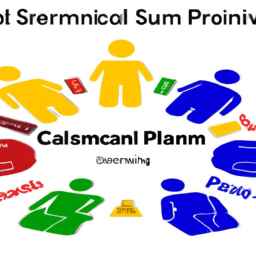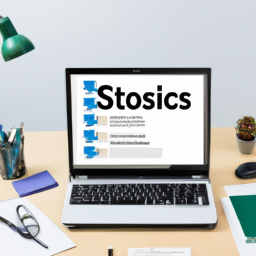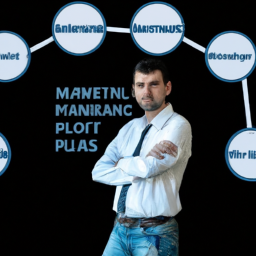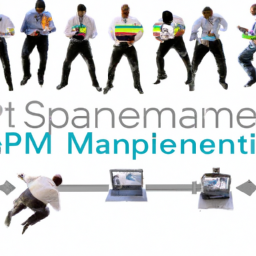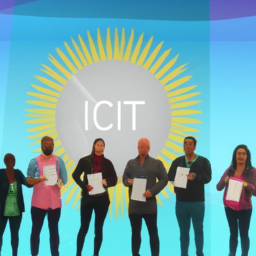Are you ready to take your Scrum knowledge to the next level? Well, look no further!
In this article, we will explore the 10 essential exam topics that will help you ace the PSM II Certification.
From understanding Agile principles and values to mastering the Scrum framework and roles, this guide has got you covered.
So, if you’re ready to level up your Scrum skills, let’s dive in and conquer the PSM II Certification together!
Key Takeaways
- Adopting an agile mindset is crucial for success in the PSM II certification exam.
- The Scrum framework and roles, including the Product Owner, Scrum Master, and Development Team, play a significant role in agile project management.
- The responsibilities of the Scrum Master and Product Owner are distinct but equally important in ensuring the success of a project.
- Effective product backlog management, sprint planning, and execution are essential components of the agile sprint process.
Agile Principles and Values
Agile principles and values are crucial for success in the PSM II certification. To excel in this exam, you must understand the importance of adopting an agile mindset and implementing agile practices.
The agile mindset emphasizes flexibility, collaboration, and continuous improvement. It encourages individuals and teams to embrace change, value customer feedback, and prioritize delivering value in short iterations.
Agile practices, such as Scrum, Kanban, and Lean, provide frameworks and tools to support this mindset. These practices promote transparency, adaptability, and self-organization.
By understanding and applying agile principles and values, you can effectively navigate complex projects, manage stakeholder expectations, and deliver high-quality products.
In the PSM II certification exam, expect questions that test your knowledge and application of these principles and values, so make sure to study and internalize them.
Scrum Framework and Roles
In this discussion, you’ll gain a comprehensive understanding of the Scrum roles and their respective responsibilities.
We’ll first delve into the Scrum Roles Explained, exploring the distinct roles of the Scrum Master, Product Owner, and Development Team.
Next, we’ll focus on the critical responsibilities of the Scrum Master, who acts as the facilitator and servant-leader for the Scrum Team.
Scrum Roles Explained
To understand the Scrum roles, you should familiarize yourself with the Product Owner, Scrum Master, and Development Team. In Scrum team dynamics, these roles play a critical part in ensuring the success of a project.
Let’s start with the Product Owner. This role represents the stakeholders and acts as the voice of the customer. They are responsible for defining and prioritizing the product backlog, ensuring that the team is working on the most valuable items.
Next, we have the Scrum Master. This role is like a coach or facilitator for the team. They help remove any impediments and ensure that the Scrum framework is followed.
Lastly, the Development Team consists of professionals who do the work of delivering a potentially releasable product increment at the end of each sprint.
Scrum roles provide clear accountabilities and empower teams, leading to increased collaboration, faster delivery, and improved customer satisfaction – all advantages of Scrum.
Responsibilities of Scrum Master
As a Scrum Master, your responsibilities include facilitating team meetings, removing obstacles, and ensuring that the Scrum framework is followed. These tasks are crucial for the success of the project and the efficient functioning of the Scrum team. Here are three key aspects of the Scrum Master’s role and responsibilities:
-
Facilitating Team Meetings: You are responsible for organizing and facilitating various meetings like daily stand-ups, sprint planning, and retrospectives. Your role is to ensure that these meetings are effective, efficient, and focused on achieving the team’s goals.
-
Removing Obstacles: As a Scrum Master, you are the advocate for the team. It is your responsibility to identify and eliminate any obstacles or impediments that might hinder the team’s progress. This can involve coordinating with other teams, stakeholders, or management to resolve issues.
-
Ensuring Scrum Framework Adherence: You play a vital role in ensuring that the Scrum framework is followed correctly. This includes coaching the team on Scrum values, practices, and principles, as well as keeping the team accountable for adhering to the agreed-upon processes.
In conclusion, the Scrum Master’s role is multifaceted, involving facilitation, obstacle removal, and framework adherence. By fulfilling these responsibilities, you enable the team to work efficiently and effectively towards achieving the project’s goals.
Now let’s explore the key tasks of the Product Owner.
Product Owner’s Key Tasks
You play a crucial role as the Product Owner, responsible for prioritizing the backlog, collaborating with stakeholders, and ensuring the delivery of high-quality products.
As the Product Owner, your responsibilities are vast and varied. You are the bridge between the development team and the stakeholders, translating their needs into actionable tasks. It is your job to prioritize the backlog items and ensure that the team is working on the most valuable features first.
You must possess strong product ownership skills, such as excellent communication, negotiation, and decision-making abilities. You need to have a deep understanding of the market, the customers, and the business goals to make informed decisions. With your expertise, you can guide the team towards delivering products that meet customer expectations and drive business success.
Now, let’s delve into the important aspect of product backlog management.
Product Backlog Management
Managing the product backlog is crucial for successful product development. It involves the continuous refinement of the backlog and prioritization of user stories. Here are three key aspects to consider when it comes to product backlog management:
-
Product backlog refinement: This involves regularly reviewing and updating the product backlog to ensure it remains relevant and aligned with the product vision. It includes breaking down user stories into smaller, actionable tasks, estimating effort, and adding new items as requirements evolve.
-
User story prioritization: Prioritizing user stories helps determine the order in which they will be implemented. By considering factors such as business value, customer impact, and technical feasibility, you can ensure that the most valuable and impactful features are delivered first.
-
Maintaining a healthy backlog: It’s essential to keep the backlog manageable and avoid it becoming overwhelming. This means regularly removing or archiving non-essential or outdated items, ensuring a balanced mix of features, and keeping the backlog transparent and accessible to the development team.
Sprint Planning and Execution
In order to successfully navigate the world of Sprint Planning and Execution, you’ll need to understand the intricacies of the Agile Sprint Process. The Agile Sprint Process is a framework that allows teams to work in short, iterative cycles, delivering valuable increments of work.
To develop effective planning techniques, you should break down the work into small, manageable tasks. This helps in estimating effort accurately and prioritizing tasks based on value and dependencies.
When it comes to execution best practices, it’s important to foster collaboration among team members. This can be done by maintaining transparency and constantly adapting and improving based on feedback and learnings.
Overall, understanding the Agile Sprint Process and implementing effective planning techniques and execution best practices will set you up for success in Sprint Planning and Execution.
Agile Sprint Process
The Agile sprint process helps you and your team deliver value to customers in short, iterative cycles. By breaking down the work into manageable sprints, you can continuously improve and adapt to changing requirements.
Here are three key aspects of the Agile sprint process:
-
Agile Sprint Planning: This crucial step involves identifying the user stories and tasks to be completed during the sprint. By collaborating with your team and stakeholders, you can prioritize the work and establish a clear goal for the sprint.
-
Sprint Backlog Management: Once the sprint begins, it’s important to regularly review and update the sprint backlog. This ensures that everyone is aware of the progress and any changes or adjustments that need to be made.
-
Iterative Delivery: The Agile sprint process emphasizes delivering small increments of working software at the end of each sprint. This allows you to gather feedback from customers early and make necessary improvements, ensuring that you’re continuously delivering value.
Effective Planning Techniques
Now that you have a good understanding of the Agile Sprint Process, let’s delve into effective planning techniques.
When it comes to managing your time and prioritizing tasks, it’s crucial to have a solid strategy in place. One effective prioritization technique is the Eisenhower Matrix, which helps you categorize tasks based on their urgency and importance. By dividing your tasks into four quadrants – urgent and important, important but not urgent, urgent but not important, and neither urgent nor important – you can prioritize your work accordingly.
Additionally, using time management strategies such as the Pomodoro Technique can help you stay focused and avoid procrastination. This technique involves breaking your work into 25-minute intervals, called ‘pomodoros,’ with short breaks in between.
Execution Best Practices
Executing tasks efficiently requires clear communication and collaboration among team members. To ensure successful execution, consider the following strategies and implementation tips:
-
Set clear expectations: Clearly define the goals, objectives, and deliverables of the task. This helps team members understand their roles and responsibilities, reducing confusion and potential errors.
-
Break down tasks: Divide complex tasks into smaller, manageable parts. This allows for better focus and improves productivity. Assigning specific tasks to team members based on their skills and expertise ensures efficient execution.
-
Foster a supportive environment: Encourage open communication and collaboration within the team. Regularly check in with team members to address any challenges or concerns they may have. Providing feedback and recognition for a job well done boosts morale and motivates team members to execute tasks with excellence.
Sprint Review and Retrospective
During the Sprint Review and Retrospective, you, as a member of the Scrum Team, reflect on your achievements and identify areas for improvement.
The Sprint Review is an opportunity to inspect the product increment and gather feedback from stakeholders. It is important to continuously improve the review process to ensure it is effective and valuable. Consider implementing improvements such as inviting a diverse group of stakeholders, creating a clear agenda, and setting specific goals for the review.
On the other hand, the Retrospective can pose challenges when it comes to identifying and addressing issues. Some common challenges include team members not feeling comfortable speaking up or being afraid of blame. It is crucial to create a safe and open environment where everyone can freely share their thoughts and concerns to overcome these challenges and make meaningful improvements.
Stakeholder Engagement and Communication
To effectively engage stakeholders and ensure clear communication, you should actively seek their feedback and involvement throughout the project. By conducting a thorough stakeholder analysis, you can identify key individuals or groups who have an interest or influence on your project’s outcome. This analysis helps you understand their needs, expectations, and potential concerns, enabling you to tailor your communication strategies accordingly.
Here are three important strategies to consider:
-
Regularly communicate project updates: Keep stakeholders informed about the project’s progress, milestones, and any changes or risks that may affect them. Utilize various communication channels such as emails, meetings, or project management tools.
-
Provide opportunities for feedback: Actively seek input from stakeholders to ensure their voices are heard. This can be done through surveys, focus groups, or one-on-one meetings. Encourage open and honest communication to address any concerns or suggestions.
-
Engage stakeholders in decision-making: Involve stakeholders in key decision-making processes to gain their buy-in and ownership. This ensures that decisions align with their expectations and reduces resistance or conflicts later on.
Scaling Scrum for Large Projects
When scaling Scrum for large projects, you may encounter various challenges that need to be addressed.
One of the key challenges is managing a distributed team, where members are located in different geographical locations. This can lead to communication and coordination difficulties, requiring effective strategies to ensure collaboration and alignment.
Additionally, implementing agile frameworks specifically designed for scaling, such as SAFe or LeSS, can help facilitate the coordination and synchronization of multiple Scrum teams working on a large project.
Challenges in Scaling
Scaling agile practices can present challenges for teams working towards the PSM II certification. As you strive to scale your agile practices, you may encounter several hurdles along the way. Here are three key challenges that you should be aware of:
-
Complexity: Scaling agile practices means dealing with more people, more dependencies, and more complexity. This complexity can make it difficult to maintain transparency, alignment, and communication across the entire organization.
-
Coordination: As teams grow and become distributed, effective coordination becomes crucial. Managing dependencies, ensuring smooth collaboration, and aligning goals can be challenging when teams are spread across different locations and time zones.
-
Culture and Mindset: Scaling agile practices requires a shift in mindset and embracing a culture of agility. However, changing the mindset of individuals and teams can be a significant challenge, especially in organizations with deeply entrenched traditional practices.
Successfully addressing these scaling challenges is essential for teams aiming to achieve the PSM II certification. It requires careful planning, strong leadership, and continuous improvement.
Transitioning seamlessly into the next section, let’s now dive into the topic of distributed team management.
Distributed Team Management
Managing a distributed team can be challenging, but with effective strategies and communication, it can lead to successful collaboration and productivity.
When it comes to team collaboration in remote work settings, it is crucial to establish clear expectations and goals for each team member. Regular check-ins and video conferences can help foster a sense of connection and keep everyone aligned.
Utilizing project management tools and collaboration platforms can further enhance team collaboration by providing a centralized space for sharing files, tracking progress, and coordinating tasks.
Encouraging open and transparent communication is also essential, as it helps overcome any potential barriers that may arise from remote work.
Agile Frameworks for Scaling
To effectively utilize agile frameworks for scaling, you should prioritize continuous improvement and adaptability in your team’s workflow. Agile scaling techniques and agile transformation strategies can help your team navigate the challenges of scaling agile practices to larger projects or organizations. Here are three key aspects to consider:
-
Embrace transparency:
Maintain clear communication channels and ensure that everyone on the team has access to the necessary information. This promotes collaboration, reduces duplication of efforts, and helps identify and address any obstacles in a timely manner. -
Foster a culture of learning:
Encourage your team members to continuously learn and improve their skills. Provide opportunities for them to attend training sessions, workshops, or conferences that focus on agile practices and scaling techniques. This will help them stay up to date with the latest industry trends and enhance their ability to adapt to changing circumstances. -
Promote cross-functional collaboration:
Break down silos and encourage collaboration between different teams or departments. By fostering a culture of collaboration, you can leverage the diverse skills and expertise of your team members to deliver high-quality products or services more efficiently.
Agile Estimation and Planning
Don’t underestimate the importance of agile estimation and planning in your journey to ace the PSM II certification.
Agile estimation techniques play a crucial role in helping teams accurately estimate the effort required for each user story or task. One popular method is Planning Poker, where team members use a deck of cards with different values to assign story points.
This technique encourages collaboration and ensures that everyone’s input is considered. By incorporating Planning Poker into your agile planning process, you can facilitate discussions, address any uncertainties, and arrive at a shared understanding of the work involved.
This helps teams make informed decisions about scope, prioritize work effectively, and deliver value in a timely manner. Remember, mastering agile estimation and planning is essential for success in the PSM II certification exam.
Agile Metrics and Reporting
When it comes to agile metrics and reporting, you’ll want to focus on selecting the most relevant metrics that provide valuable insights into your team’s performance. Agile metrics analysis is an essential aspect of agile project management, as it helps you understand how your team is progressing and identify areas for improvement.
To effectively analyze agile metrics, consider the following reporting techniques:
-
Velocity: Measure the speed at which your team is delivering value by tracking the number of user stories completed in each iteration. This metric provides a clear indication of your team’s productivity and helps you make informed decisions about future planning.
-
Cycle Time: Understand how long it takes for a user story to move through the entire development process, from start to finish. This metric helps you identify bottlenecks and streamline your workflow, ultimately improving overall efficiency.
-
Burnup and Burndown Charts: Visualize the progress of your project by tracking the completion of user stories over time. Burnup charts show the total work completed, while burndown charts illustrate the remaining work. These charts provide a clear picture of your team’s progress and help you manage expectations.
Continuous Improvement and Adaptation
Now that you understand the importance of Agile Metrics and Reporting, let’s delve into the next crucial topic for acing the PSM II certification: Continuous Improvement and Adaptation.
Agile methodologies thrive on the principles of continuous improvement and adaptive practices. As a Scrum Master, your role is to facilitate this process and enable your team to embrace change.
Continuous improvement involves regularly reflecting on the team’s performance, identifying areas of improvement, and implementing changes to enhance productivity and efficiency.
Adaptive practices, on the other hand, require the team to be flexible and responsive to changing circumstances, adjusting their approach as needed.
Frequently Asked Questions
What Are the Key Differences Between the PSM II and PSM I Certifications?
The key differences between the PSM II and PSM I certifications lie in their levels of complexity and the scope of knowledge required.
While the PSM I certification focuses on the foundational understanding of Scrum principles and practices, the PSM II certification delves deeper into advanced topics like scaling Scrum, organizational change, and coaching.
Obtaining the PSM II certification demonstrates a higher level of expertise and readiness for more challenging Scrum roles.
How Does the Concept of "Inspect and Adapt" Apply to Scrum?
When it comes to the concept of ‘inspect and adapt’ in Scrum, it plays a crucial role in the Scrum implementation.
This principle emphasizes the importance of continuous improvement. By regularly inspecting the progress and adapting the process, teams can identify areas for improvement and make necessary adjustments.
This ensures that the team is constantly learning and evolving, leading to better outcomes and higher customer satisfaction.
Overall, ‘inspect and adapt’ is a fundamental aspect of successful Scrum practices.
Can You Provide an Example of a Situation Where Scaling Scrum for Large Projects Would Be Necessary?
Scaling Scrum for large projects becomes necessary when the complexity and size of the project surpass the capacity of a single Scrum team. In such situations, multiple Scrum teams are required to collaborate and coordinate their efforts to deliver the desired outcome.
This approach ensures efficient resource utilization, effective communication, and timely delivery. By scaling Scrum, organizations can effectively manage large projects while maintaining the agility and flexibility that are integral to the Scrum framework.
What Are Some Common Challenges Faced When Implementing Scrum in an Organization?
When implementing Scrum in an organization, you may face some common challenges.
One challenge is organizational resistance, where people are hesitant to adopt the Scrum framework due to fear of change or unfamiliarity.
Another challenge is a lack of understanding of Scrum principles, which can lead to confusion and ineffective implementation.
Overcoming these challenges requires clear communication, education, and strong leadership to help the organization embrace Scrum and reap its benefits.
How Can Agile Metrics and Reporting Help Teams Improve Their Performance?
Agile metrics and reporting are essential for improving team performance. By measuring and analyzing key metrics, you can gain valuable insights into your team’s progress and identify areas for improvement.
These metrics provide a clear picture of how well your team is performing, allowing you to make informed decisions and take necessary actions. With the right metrics in place, you can track your team’s success, identify bottlenecks, and make data-driven decisions to continuously improve performance.
Conclusion
In conclusion, mastering these 10 essential exam topics will undoubtedly lead to success in obtaining the PSM II certification.
By understanding the Agile principles and values, as well as the Scrum framework and roles, you will be equipped with the knowledge to effectively manage product backlogs, plan and execute sprints, and conduct insightful reviews and retrospectives.
Furthermore, learning how to scale Scrum for large projects, estimate and plan in an agile manner, and utilize metrics for reporting will enhance your ability to continuously improve and adapt.
Investigating the truth of theories adds depth to your understanding, hooking the audience with a profound level of expertise.





